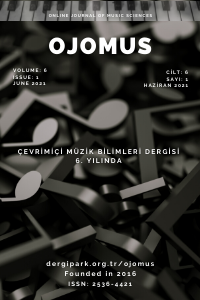YORGO BACANOS’UN PEŞREV FORMUNDAKİ ESER İCRASININ UD TEKNİĞİ BAKIMINDAN İNCELENMESİ; REFİK FERSAN’IN ŞEDARABAN PEŞREVİ ÖRNEĞİ
Türk musiki tarihinin yetiştirdiği önemli udilerden olan Yorgo Bacanos gerek taksimleri ve solist eşlikleri bakımından gerekse de icra ettiği saz eserlerindeki üstün performansları sebebiyle ekol olmuş isimlerden biridir. Günümüzde Bacanos ekolünü örnek alarak kendi icralarında bu ekolden örnekler sergileyen profesyonel ud icracıları olduğu gibi ud öğrencilerinin de onun taksimlerini dinleyip taklit etmeye çalıştıkları gözlemlenmektedir. Çalgı çalmayı öğrenme süresince iyi bir seviyeye ulaşmak için ekol olmuş üstadların ses kayıtları üzerine çalışmalar yaparak bu icraların taklit edilmesinin sürece olumlu katkılarda bulunduğu artık kabul görmüş bir eğitim modelidir. Bu model, günümüzde teknolojinin de sunduğu imkanlar dahilinde aslında meşk sisteminin bir parçası olmuştur. Bacanos’un icrası vesilesiyle yorumculuğun geliştirilmesine katkı sağlamak araştırmanın temel amacını oluşturmaktadır. Bulgular nitel araştırma yöntemlerinden betimsel analiz yöntemi ile değerlendirilmiştir. Bu çalışmada, Kalan Müzik tarafından yayınlanan “Yorgo Bacanos 1900 – 1977 / Arşiv” adlı albümün içinde yer alan bir kayıt ele alınarak Yorgo Bacanos’un Ud icrası teknik bakımdan incelenmiştir. Araştırmacı tarafından Yorgo Bacanos’un eser içerisinde yapmış olduğu tüm nota dışı süslemeler ve ud tekniğini içeren öğeler de dahil olmak üzere ilgili kayda göre yeniden notası yazılmıştır. Ayrıca eserin orijinal haliyle kıyaslanması açısından 2 parti olacak şekilde gösterilmiştir. Yapılan analizlere göre Bacanos’un eser içerisindeki uzun sesli kalışları kendine has ajiliteli özgün kalıplarla doldurduğu, yer yer çift sesler, atlamalı aralıklar ve akorlar kullandığı tespit edilmiştir.
Anahtar Kelimeler:
ud, yorgo bacanos, klasik türk müziği, ud tekniği, refik fersan
INVESTIGATION OF YORGO BACANOS’ PERFORMANCE IN THE PEŞREV FORM IN TERMS OF OUD TECHNIQUE; THE EXAMPLE OF REFİK FERSAN’S ŞEDARABAN PEŞREVİ
Yorgo Bacanos, who is one of the important oud players raised in the history of Turkish music, is one of the names that became a school both in terms of his taksims and soloist accompaniments, and reason of his outstanding performances in the instrumental works he performed. Today, it is observed that there are professional oud players who take the Bacanos school as an example and exhibit examples from this school in their performances, and that the oud students listen to his taksims and try to imitate them. In order to reach a good level during learning to play the instrument, it is an accepted education model that studies on the sound recordings of the masters and imitation of these performances contribute positively to the process. This model has actually become a part of the meşk system within the possibilities offered by technology today. Contributing to the development of interpretation through the performance of Bacanos is the main purpose of the research. The findings were evaluated with the descriptive analysis method, one of the qualitative research methods.In this study, Yorgo Bacanos' oud performance was technically examined by considering a recording in the album "Yorgo Bacanos 1900 – 1977 / Archive" published by Kalan Music. In the aforementioned recording, The notation was rewritten by the researcher according to the relevant record, including all the non-note decorations and elements containing the oud technique that Yorgo Bacanos made in the piece. In addition, it is shown as 2 parties in order to compare the work with its original form. According to the analyzes made, it has been determined that Bacanos fills the long sounds in the piece with unique patterns with his own agility, and sometimes he uses double sounds, hopping intervals, arpeggio and chords.
Keywords:
yorgo bacanos, oud, classical turkish music, oud technique, refik fersan,
___
- Çalışır, F. (2004). Müzik dili sözlüğü. Ataçağ Sanatevi Yayınları.
- Özalp, D. M. (2000). Türk musikisi tarihi II. Milli Eğitim Bakanlığı Yayınları.
- Özgen, İ. (2009). Sanatı yaşamak. Yapı Kredi Yayınları.
- Ak, A. Ş. (2009). Türk musikisi tarihi. Akçağ Yayınları.
- Aslan, E. M. (2017(11)). İstanbul lavtası ve Yorgo Bacanos'un ud icrasındaki lavta etkileri. EÜ Devlet Türk Musikisi Konservatuarı Dergisi, 11, 73-84. https://doi.org/10.31722/ejmd.546069
- Behar, C. (2019). Aşk olmayınca meşk olmaz.Yapı Kredi Yayınları.
- Kaçar, G. Y. (2005). Geleneksel Türk sanat müziği'nde süslemeler ve nota dışı icralar. Gazi Eğitim Fakültesi Dergisi, 25(2), 215-228. https://dergipark.org.tr/tr/download/article-file/77259
- Kaçar, G. Y. (2020). Türk musikisinde eser ve icra tahlili yöntemleri. Gece Kitaplığı. Karahasanoğlu, S., & Yavuz, E. (2015). Müzikte araştırma yöntemleri. İstanbul Teknik Üniversitesi Türk Musikisi Devlet Konservatuarı Yayınları.
- Merriam, S. B. (2009). Qualitative research: A guide to design and ımplementation. Wiley.
- Sözer, V. (2005). Müzik ansiklopedik sözlük. Remzi Kitabevi.
- Sözer, V. (2021). Müzik terimleri sözlüğü. Remzi Kitabevi.
- Simonson, M., Smaldino, S. E., Albright, M., ve Zvacek, S. (2012). Teaching and learning at a distance: Foundations of distance education. Pearson Education, Inc.
- Tanrıkorur, C. (2004). Türk müzik kimliği. Dergah Yayınları.
- Taylor, J. C. (2001). Fifth generation distance education. e-Journal of Instructional Science and Technology (e-JIST), 4 (1), 1-14.
- Torun, M. (2000). Ud Metodu "Gelenekle Geleceğe". Çağlar Yayınları.
- Turgay, N. Ö. ve Ayangil, R. (2016). Fasıl müziği icrasında nota dışı farklılıklar. Rast Müzikoloji Dergisi 4 (1), 1165-1184. https://dergipark.org.tr/tr/download/article-file/545802
- ISSN: 2536-4421
- Yayın Aralığı: Yılda 2 Sayı
- Yayıncı: Nilgün SAZAK
Sayıdaki Diğer Makaleler
NOTA YAZISININ BİLGİSAYAR ORTAMINA AKTARIMI SÜRECİNDE İZLENECEK YÖNTEMLER (FİNALE ÖRNEĞİ)
Alp Eray TUĞCULAR, Selçuk BILGIN
2. DÜNYA SAVAŞI DÖNEMİNDE KLASİK MÜZİK VE MÜZİKSEL GELİŞMELER
Aşkın BAKBAK, Tuğçe KAYNAK AKÇAOĞLU
MÜZİK ÖĞRETMENLİĞİ PROGRAMLARINDAKİ MÜZİK TEKNOLOJİSİ DERSLERİNE İLİŞKİN BİR İNCELEME
